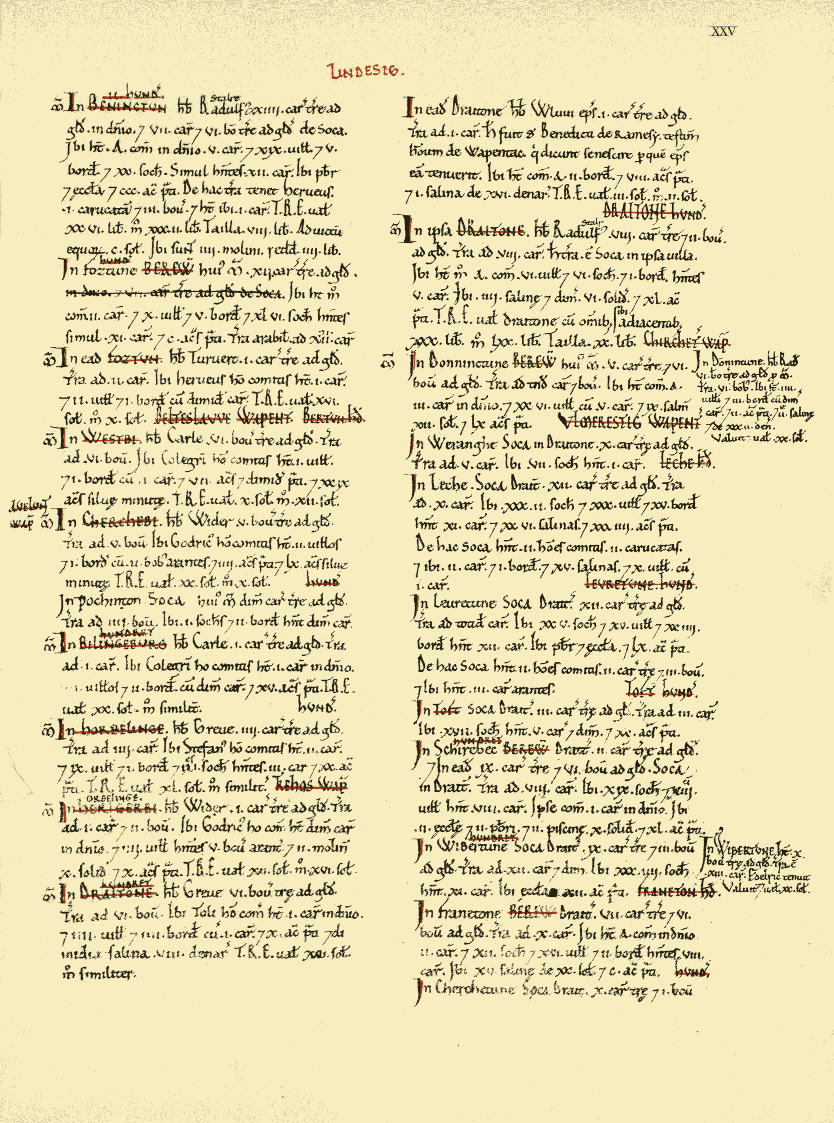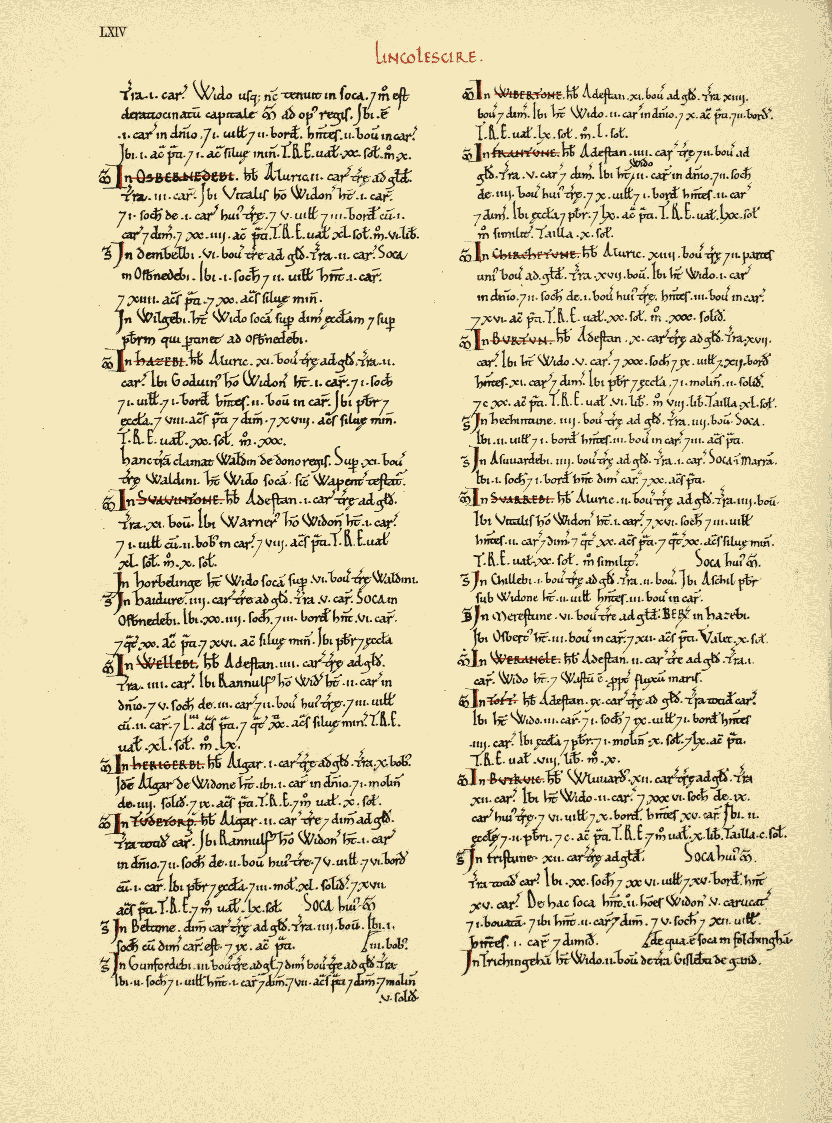Fishtoft
Fishtoft was a settlement in Domesday Book, in the hundred of Wolmersty and the county of Lincolnshire.
It had a recorded population of 29 households in 1086, putting it in the largest 40% of settlements recorded in Domesday, and is listed under 2 owners in Domesday Book.
Land of Count Alan (of Brittany)
Households
- Households: 17 freemen.
Land and resources
- Ploughland: 3 ploughlands. 5.5 men's plough teams.
- Other resources: Meadow 20 acres.
Owners
- Tenant-in-chief in 1086: Count Alan (of Brittany).
- Lord in 1086: Count Alan (of Brittany).
- Lord in 1066: Earl Ralph the constable.
Other information
- Phillimore reference: Lincolnshire 12,66

Land of Guy of Craon
Households
- Households: 9 villagers. 1 freeman. 1 smallholder. 1 priest.
Land and resources
- Ploughland: 9 ploughlands. 3 lord's plough teams. 4 men's plough teams.
- Other resources: Meadow 60 acres. 1 mill, value 10 shillings. 1 church.
Valuation
- Annual value to lord: 10 pounds in 1086; 8 pounds in 1066.
Owners
- Tenant-in-chief in 1086: Guy of Craon.
- Lord in 1086: Guy of Craon.
- Lord in 1066: Aethelstan (son of Godram).
Other information
- Phillimore reference: Lincolnshire 57,37

The status of households depended on their land and resources. The largest groups recorded are:
- Villagers and freemen: around 40% of households, villani, socmani and franci homines were small-scale landholders, owning on average 30 acres of land, and two oxen for ploughing.
- Smallholders and cottagers: around 35% of households, bordarii and cotarii owned about 5 acres of land on average and might have had a share in the villagers' plough teams.
- Slaves: around 10% of households, servi owned no land of their own, belonged to the lord, and may have been used as ploughmen.
Domesday records the heads of families, so the total population was probably around five times larger.
Other households are sometimes noted, including priests, widows, burgesses (townspeople), and Frenchmen (probably a local military presence).
For more information, see the Hull Domesday Project's guide to the peasantry and occupations.
Arable land was recorded in different units, including:
- Ploughlands, carucates, hides: A ploughland (terra carucis or carucata) was the area that could be ploughed by eight oxen in a year. Generally around 120 acres, though the area varied depending on the quality of the land. Learn more.
- Plough teams: Groups of eight oxen (which indicated how much land could be ploughed): sometimes belonging to the peasants and sometimes to the lord.
Other taxable resources were also recorded, including:
- Woodland: Usually quantified by the number of pigs it supported. About 15% of the country was forested in 1086.
- Meadow and pasture: Used to graze animals, typically sheep.
- Mills: Water mills were the main source of power besides oxen: more than 6,000 are recorded in Domesday.
- Fisheries and salthouses: Important economic resources: the salt industry is the most fully documented industry in Domesday. Tax on fisheries was often paid in fish.
For more information, see the Hull Domesday Project's guide to manors and to weights and measures.
Livestock was not consistently counted in Domesday Book. It is mainly recorded in Essex, Norfolk and Suffolk, and sometimes in Cornwall, Devon, Dorset and Somerset.
Where livestock is recorded, it counts only the animals belonging to the lord.
Nonetheless, sheep, goats, cows, pigs, cattle, and cobs (horses) are all recorded in substantial numbers. Sheep are by far the most numerous animal recorded.
For more information, see the Hull Domesday Project's guide to livestock.
Most entries record the total annual value of the estate in 1086 and 1066. This was probably to help the Crown calculate how much tax the lord should be charged.
Some estates gain in value between 1066 and 1086: others lose value, and some are wiped out entirely.
For more information, see the Hull Domesday Project's guide to taxation and tax assessment.
Domesday carefully records the owners of each manor (estate) in 1086, as these were the people liable for tax. All land was ultimately owned by the Crown, but held by lords, who provided military resources or tax in return.
- Tenant-in-chief in 1086: The main landholders listed in Domesday Book. Either King William himself, or one of around 1,400 people who held land directly from the Crown, mostly Norman knights.
- Lord in 1086: The immediate lord over the peasants after the Conquest. Sometimes the same as the tenant-in-chief, sometimes a tenant granted the estate in return for tax.
Domesday also records the equivalent owners before the Conquest in 1066. For more information, see the Hull Domesday Project's guide to landholding.
- Waste: Estates described as "waste" paid no tax. About 10% of all the estates in Domesday are waste. Most are in the North or on the Welsh Borders, and were probably destroyed in fighting after the Conquest. For more information, see the Hull Domesday Project's guide to waste.
- Phillimore reference: The section number in the Phillimore translation of Domesday Book, from which this information is taken. Consult the Phillimore translation for the full text.

